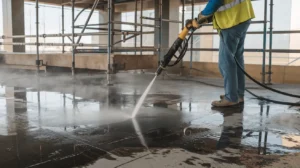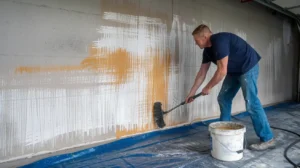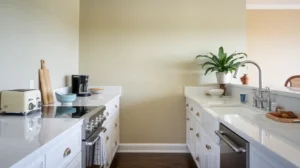How to Clean Concrete Floor | A Step-by-Step Guide for...
Read MoreHow to Re-Polish Granite Countertops
Transforming the look of your kitchen or bathroom with gleaming granite countertops is a timeless choice in home design. Over time, however, even the most stunning granite surfaces can lose their lustre due to wear and tear. If you’re looking to restore the brilliance of your granite countertops, learning how to re-polish them is key. In this guide, we’ll delve into the step-by-step process of revitalizing your granite surfaces, ensuring they regain their natural beauty and durability.
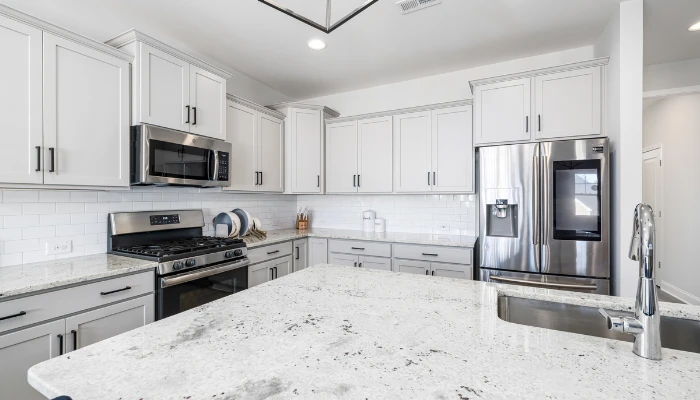
How to Re Polish Granite Countertops
Despite its toughness, granite can still lose its lustre over time due to wear and tear, surface damage like scratches or etching, or exposure to harsh chemicals. When this happens, repolishing becomes necessary to restore its shine and smoothness. Factors such as heavy usage, improper cleaning methods, or the quality of the original polishing can all contribute to the need for repolishing.
The Polishing Process:
The process of repolishing granite involves several steps. First, the surface must be thoroughly cleaned to remove any dirt, grime, or residue. Next, any scratches or imperfections are addressed using diamond abrasive pads or polishing compounds. Finally, a sealant may be applied to protect the newly polished surface and enhance its longevity. The tools and materials required for this process typically include diamond polishing pads, polishing compounds, a buffer or polisher, and a sealant appropriate for granite.
Professional vs. DIY Polishing:
Deciding whether to hire a professional or attempt DIY polishing depends on various factors. While hiring a professional ensures expertise and may yield superior results, it can also be more costly. On the other hand, DIY polishing offers convenience and cost savings but requires careful attention to detail and the proper use of equipment to avoid damaging the granite surface. Factors such as the extent of damage, the desired outcome, and personal skill level should all be considered before making a decision. Stone Sealer Restoration Provides the best services related of How To re Polish Granite Countertops.
Understanding Granite Polishing
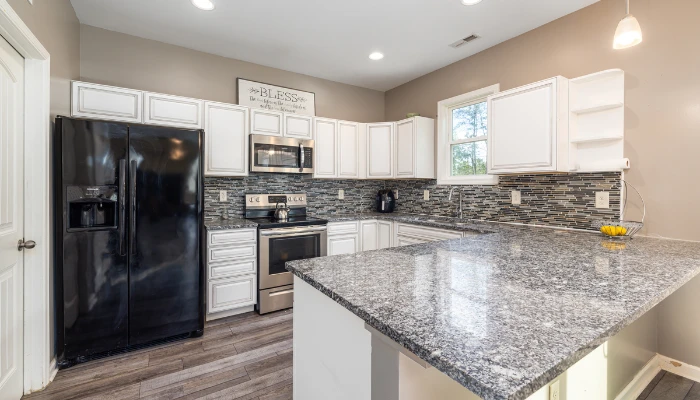
Assessing the Condition:
Before diving into the polishing process, it’s essential to assess the current state of your granite countertops. Look for dull areas, scratches, or stains that might detract from their appearance. This evaluation will help you prioritize areas that require polishing and determine the level of effort needed.
Identifying areas that require polishing:
Take note of any dull spots or uneven surfaces on the countertop. These are typically areas that have lost their shine due to wear and tear or exposure to acidic substances. By identifying these spots, you can focus your Marble polishing efforts where they are needed most.
Preparation:
Before polishing, it’s crucial to prepare the countertop surface properly. Start by cleaning the countertop with a mild detergent and warm water to remove any dirt, grease, or grime. For stubborn stains, you can use a mixture of baking soda and water or a specialised granite cleaner. Once the surface is clean, dry it thoroughly with a clean cloth.
Polishing Techniques:
There are several methods for polishing granite countertops, depending on the level of shine you want to achieve and the tools and products available to you. Here’s a basic step-by-step guide:
Choose the right polishing product: There are various granite polishing powders, creams, and sealants available on the market. Select one that suits your needs and follow the manufacturer’s instructions.
Apply the polish: Follow the instructions on the product packaging to apply the polish to the countertop surface. Use a clean, soft cloth or a buffing pad to spread the polish evenly over the entire countertop.
Buff the surface: Using a buffing pad or a polishing machine, buff the countertop surface in circular motions to evenly distribute the polish and restore its shine. Start with a low-speed setting and gradually increase the speed as needed.
Repeat if necessary: Depending on the condition of the countertop, you may need to repeat the polishing process multiple times to achieve the desired results.
Maintenance Tips:
To maintain the shine and lustre of polished granite countertops, follow these tips:
- Clean spills promptly to prevent staining.
- Use coasters or mats under glasses and hot pans to protect the surface from scratches and heat damage.
- Avoid using harsh or abrasive cleaners that can dull the polish.
- Periodically reapply a granite sealant to protect the surface and maintain its shine.
Granite Polishing Options and Techniques
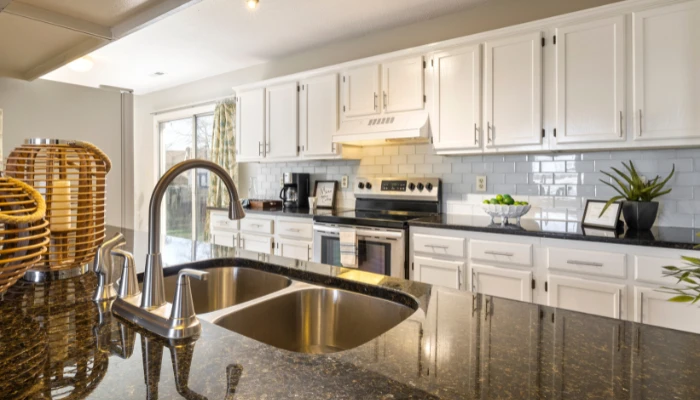
Traditional Polishing Methods:
Diamond Polishing Pads: These are widely used for granite polishing. They come in different grit sizes for coarse to fine polishing.
Pros: Effective at removing scratches and achieving a glossy finish.
Cons: Can be time-consuming and require multiple steps for optimal results.
Abrasive Compounds: These include polishing powders and pastes applied with buffing pads.
Pros: Can be used for spot polishing and minor repairs.
Cons: May not be as effective for deep scratches or large surface areas.
Modern Polishing Technologies:
Diamond Polishing Machines: These are power tools equipped with diamond-coated discs for fast and efficient polishing.
Pros: Speeds up the polishing process and provides consistent results.
Cons: Initial investment cost can be high, and proper training is necessary for safe operation.
Laser Polishing: Emerging technology that utilises laser beams to heat and melt the surface of the granite, resulting in a polished finish.
Pros: Precise control over the polishing process, minimal material waste.
Cons: Limited availability and high cost of equipment.
Specialty Polishing Products:
Sealers: Used to protect granite surfaces from stains and moisture penetration.
Enhancers: Enhance the natural colours and patterns of granite while providing some level of protection.
Topical Coatings: Provide a glossy or matte finish and additional protection against scratches and etching.
Pros: Enhance the appearance and durability of granite surfaces.
Cons: May require regular reapplication, can alter the natural look of the stone.
Expert Tips and Techniques:
Proper Surface Preparation: Clean the surface thoroughly and repair any chips or cracks before polishing.
Use the Right Tools and Products: Select the appropriate grit size and polishing pads for the desired finish.
Work in Small Sections: Focus on one area at a time to ensure even polishing and avoid overworking the surface.
Follow Manufacturer’s Guidelines: Read and follow instructions for polishing products and equipment to avoid damage to the granite.
Conclusion
Clean the surface thoroughly with a mild detergent and water to re-polish granite countertops. Next, use a granite polish specifically designed for countertops. Apply the polish in small, circular motions using a soft cloth or a buffing pad. Work in sections, ensuring even coverage. Once applied, buff the surface with a clean, dry cloth to remove any excess polish and achieve a smooth, shiny finish. Repeat the process as needed to achieve the desired level of shine. Feel free to contact us for service-related queries about How to re Polish Granite Countertops.
FAQs
What Is The Process Of Re-Polishing Granite Countertops?
Re-polishing granite countertops involves several steps including cleaning the surface, repairing any damages, honing the surface, and finally polishing it to restore its shine.
Can I Re-Polish Granite Countertops Myself Or Do I Need Professional Help?
While it is possible to re-polish granite countertops yourself, it requires specialised tools and expertise. Hiring a professional is recommended for best results, especially if you’re not experienced in stone restoration.
What Tools And Materials Do I Need To Re-Polish Granite Countertops?
You’ll need a diamond polishing pad, polishing compound, honing powder, a variable-speed polisher, protective gear (such as goggles and gloves), and cleaning supplies (such as stone-safe cleaner and soft cloths).
How Often Should Granite Countertops Be Repolished?
The frequency of re-polishing granite countertops depends on factors such as usage, the type of sealer applied, and the quality of the original polish. Generally, it’s recommended to re-polish them every 3-5 years to maintain their appearance and durability.
Can I Re-Polish Etched Or Damaged Areas On Granite Countertops?
Yes, etched or damaged areas on granite countertops can often be re-polished to restore their appearance. However, deep scratches or extensive damage may require professional repair services.
Our Services
Our Recent Post
Top 7 Popular Quartz Countertops Colors in 2024
Top 7 Popular Quartz Countertops Colors in 2024 Quartz countertops...
Read MoreHow to Clean a Granite Composite Sink | Simple Steps for a Spotless Finish
How to Clean a Granite Composite Sink | Simple Steps...
Read More
